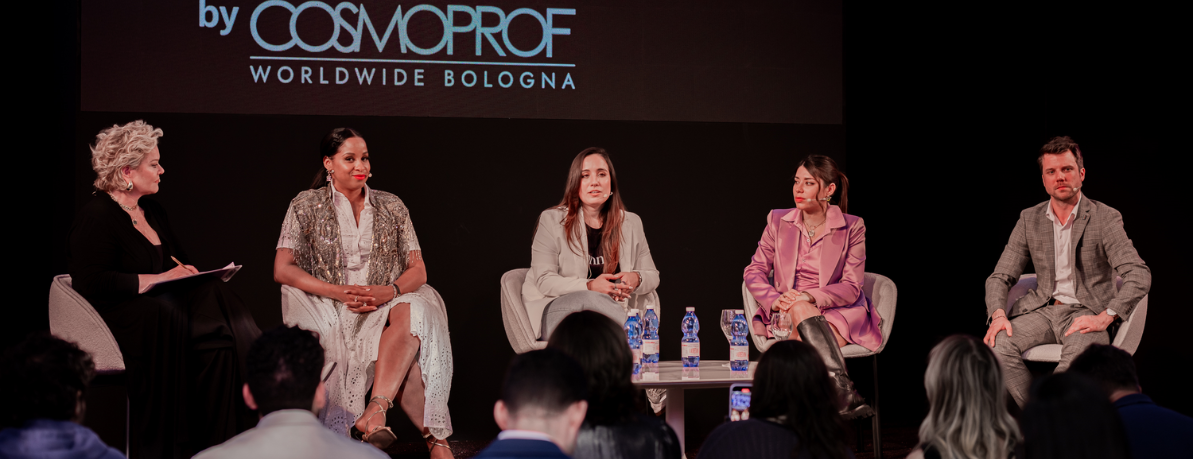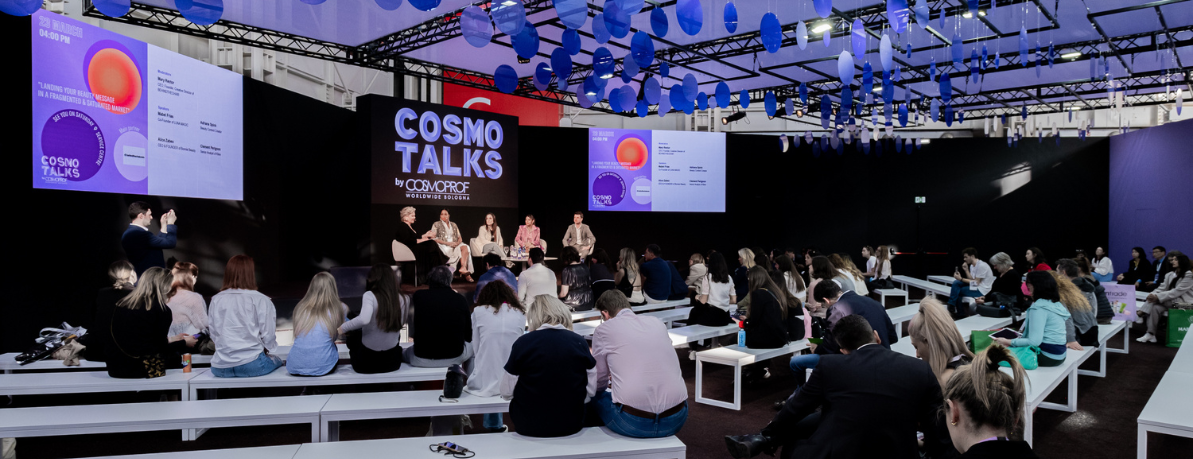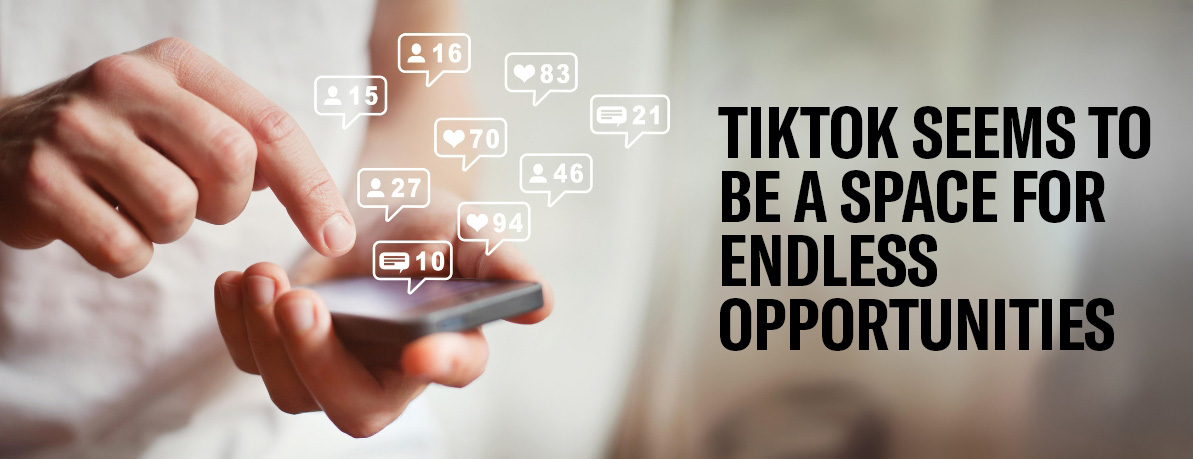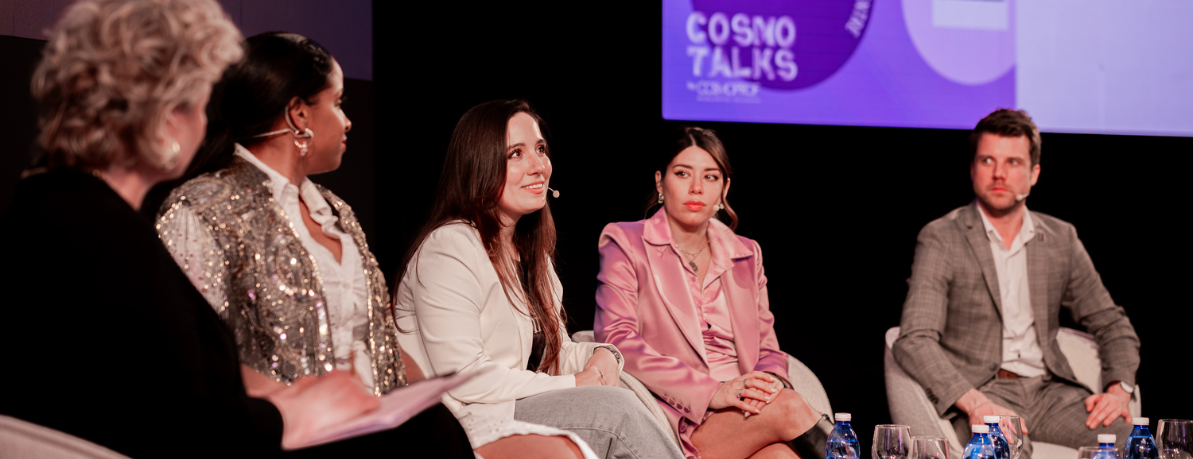NEWS > 27 May 2024
Creating a strong connection with consumers has always been the first step for beauty brands to stay on the market, but tools and strategies to achieve this goal have radically changed. Magazines have gradually disappeared leaving the space to digitalization, and brands today must look for reach on social media to be visible among consumers in a highly-competitive market.
Influencers and content creators are today the new media for advertisers and brand owners, but it is not easy to navigate into the complex and fragmented scenario of influencers marketing. During the last edition of Cosmoprof Worldwide Bologna the challenges and opportunities of influencers marketing have been discussed on the occasion of the round table “Landing your beauty message in a fragmented & saturated market”, which was part of the CosmoTalks calendar.
The discussion was moderated by Mary Rector, CEO, Founder, Creative Director of BEHINDTHECHAIR, the digital magazine based in the US and focused on the hair sector. “In the US and in Europe we are so overstocked by lots of influencers, it is necessary to work in different ways”, underlined Rector.

Lots of companies look for big profiles and influencers with huge numbers of followers, but in the end these collaborations turn to be unengaging and ineffective. Influencers can have million of followers but they may not be able to really incentivize their audience. Authenticity and data analysis are the key elements when approaching a content creator as a brand, as highlighted by Mabel Frias, Co-Founder of Luna Magic, a beauty brand for Latinas: “The right path for my brand was to build a micro-influencers community, looking for profiles interested in doing true promotion, creating organic contents, and becoming ambassadors. We invested lot of time meeting them in person, building a personal relationship, sharing our strategy and all the details about our products. In the end, instead of telling them what to do and how, we treated them like partners, we listened to their feedback, and they became part of our project. We are building our business together”.
Alice Zabeo, CEO & Founder of Bonnie Beauty, a start-up brand specialized in personalized skincare based on AI, confirmed the importance for a brand of building an authentic relation with influencers and content creators: “As a brand owner you have to build at the same time your brand identity and your customers base. It is extremely important to create a sense of community and to create a direct relationship with your consumers, and we work a lot in social media and influencers marketing to do that.”
Managing the relationship with creators is vital for brands. As emerged during the round table at Cosmoprof Worldwide Bologna, companies should have a dedicated team communicating with influencers, helping them creating the right contents, and teaching them how to work better and better, too. At the end, the creators will be true evangelists. Such an approach is important from the perspective of influencers, too, as explained by Adriana Spink, a very renowned Beauty Content Creator in Italy. “Influencers have to build a community from their side as well, and they must keep the trust of their followers. This is why it is important to choose the right brand for a collaboration from our side as well”, highlighted Spink. “I think that influencers should really fall in love with a brand they work with, and companies should take care of their creators. It’s not only a matter of money: I love when brands invite me to visit their headquarter, or to take part in some exclusive launches or events”.

Influencers marketing and digital communication do not follow the same principles everywhere. On the contrary, there is huge disparity among different regions and countries, as highlighted by Clément Perpignan, Senior Analyst of Kline + Company, a global market intelligence and advisory firm analysing beauty and wellbeing trends and economics in across more than 32 markets globally. “China is making the difference today. It is a highly digitalized market with huge quantity of users’ generated contents. 46% of sales for professional hair care in China are made on on-line and e-commerce channels: it’s an incredible rate when thinking that globally e-commerce sales represent 19%, and 9% in Italy”.
One of the most dynamic professional hair care channel in China is social-commerce: TikTok and WeChat stores are everywhere in the region. Naming big companies making business in China, Perpignan underlined that L’Oréal and Kérastase made both a partnership with TikTok. Kérastase achieves 86% of its sales in Mainland China on-line. “Brands in the country use digital tools because they need to target to a young audience: the average population in Mainland China is 36 years old. In Italy and in Europe, on the other hand, the average population is much older, therefore, the new digital solutions are less developed compared China. This means less opportunities for companies when compared to competitors in Asia”, underlined Perpignan.

In the actual ever-evolving market, social media and their use differ from one country to the other. Today TikTok is playing a key role for communication managers and advertisers: TikTok seems to be a space for endless opportunities, where brands and creators can explode in one second, but in reality you can get down even faster, if you are not able to use the tool properly.
TikTok is influencing the daily life of young generations globally. As underlined by Mary Rector, “in the US 300,000 Americans are making their living on TikTok actually, and in China people spend almost 40 minutes a day on the social media platform, which is not only a space for entertainment, but a reference for news and updates, too.”
“The social media platform is an amazing tool for content creators, and brands should start using it and understanding its rules, but they are still afraid”, highlighted Adriana Spink.
“it is because on TikTok you have to be cringy, and not all brands accept to adopt a cringy tone of voice”, echoed Alice Zabeo. “TikTok is a good tool for personal branding: founders should make a bigger use of the platform”.
“TikTok is a one-to-one-relationship-building record, which works really well for young demographics. Compared to Instagram, where contents have become obvious and standardized, contents on TikTok are disruptive and more authentic. Anyway, it can be a risky channel, because on TikTok brands are requested to take a position on specific topics or values, and this can even destroy your brand reputation”, explained Mabel Frias.

To emerge among your competitors and get in touch with the right consumers, brands must be creative and think out of the box. Despite focusing on big numbers, it is more rewarding to work with niche influencers and communities, because it is easer to acquire evangelists inside small and interconnected groups. “If I should give a suggestion to a brand today, I would recommend to remain as much focused as possible, niche-down, and to keep communicating with customers in an authentic way”, summed-up Mary Rector. “The first step is to know your consumers and start from a niche perspective. You will never find success by being everything for everybody: you cannot know everybody, and you cannot be appreciated by everybody”.
